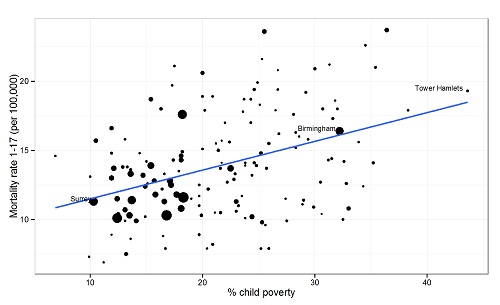The government’s plan to repeal the 2010 Child Poverty Act, which committed it to eradicating child poverty in the UK by 2020, and dispense with the current definition of child poverty is highly concerning. Especially when you consider this plan in the context of a recent report by the four UK children’s commissioners, which stated that levels of child poverty in the UK were “unacceptably high” and expected to rise.
Iain Duncan Smith has indicated that the standard definition of relative child poverty (a household income below 60% of contemporary median) will be replaced with measures of “worklessness:” family breakdown, addiction, debt, and educational attainment. Details of how this “new” definition of child poverty will be formulated, and what the targets are, have not been outlined. This is concerning because an unvalidated and unclear measure of child poverty may be open to political manipulation.
No single measure of child poverty can capture the full picture. One reason the government has cited for ditching the relative income measure of child poverty is that in the context of the 2008/2009 economic recession, child poverty appeared to fall. However, this was because the overall UK median income fell. The absolute poverty measure, which is adjusted for inflation, indicates poverty has risen—both before and after housing costs are accounted for.
Relative income measures of poverty are an international standard used by the European Union, the Organisation of Economic Co-operation and Development, UNICEF, and most income rich countries. The measure is highly correlated with child health (figure 1). Children who grow up in poverty are more likely to have been born prematurely, die within the first year of life, develop obesity, have behavioural problems, and perform less well at school. These adverse risks also extend into adulthood, increasing the risk of poor health and social outcomes across the life course.
 Figure 1. Child mortality rate (age 1-17 years) for upper tier local authorities in England by relative child poverty. Directly standardised rate per 100 000 population. This figure was created by David Taylor-Robinson, one of the authors, using data from ChiMat, which is an open source.
Figure 1. Child mortality rate (age 1-17 years) for upper tier local authorities in England by relative child poverty. Directly standardised rate per 100 000 population. This figure was created by David Taylor-Robinson, one of the authors, using data from ChiMat, which is an open source.
But now more than ever a poverty measure based on income is important. The Institute for Fiscal studies has predicted a decade of rising child poverty, unprecedented since records began in the 1960s. The cuts to working age benefits announced in the chancellor’s summer budget, which included a limitation on child tax credits to two children only and a £6000 lowering of the household benefit cap, are likely to make the situation worse.
The current policy response to the shameful levels of child poverty in the UK appears to be to obfuscate the measure. We suggest that paediatricians should be “up in arms” about the proposed changes. Considering that around one in three of our patients are already living in poverty, we must demand real action and certainly not permit any attempt to hide the true scale of the problem.
Caoimhe McKenna is a paediatrician working in North London and an academic clinical fellow at the Institute of Child Health, UCL. She has a special interest in the social determinants of health and the impact of economic policy on child health. She is also a member of the International Society of Social Paediatrics (ISSOP).
David Taylor-Robinson is a clinical senior lecturer at the Department of Public Health and Policy at the University of Liverpool. He is also an honorary clinical senior lecturer at the Institute of Child Health, UCL.
Sophie Wickham is a research fellow at the Department of Public Health and Policy at the University of Liverpool. Sophie’s research interests since working at the department revolve around the role policy interventions have on the social determinants of health inequalities.
Rosie Kyeremateng is a community paediatric trainee in the South West of England with interests in public health, global health, and children’s environmental health. Rosie is author of the “Infection in Schools” module of the RCPCH Healthy Schools Programme, and she has contributed to a child rights curriculum in association with the Open University. She is also the trainee representative on the International Society of Social Paediatrics (ISSOP) executive committee.
Benjamin Barr is a senior clinical lecturer in applied public health research at the Department of Public Health and Policy at the University of Liverpool.
Competing interests: None declared.
This blog was also published on the Archives of Disease in Childhood‘s blog site.
